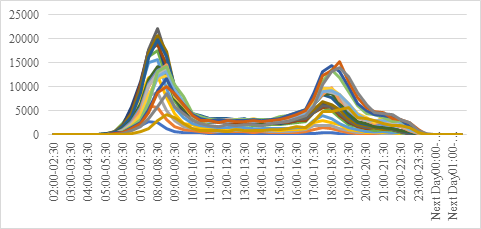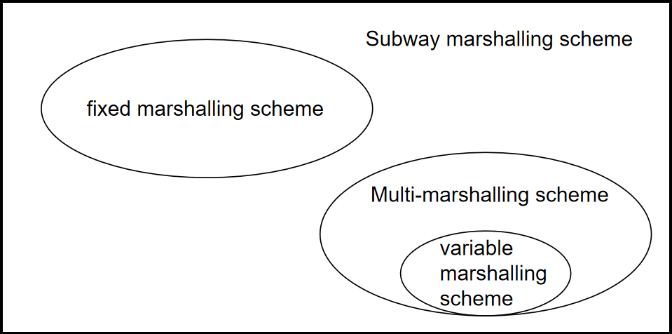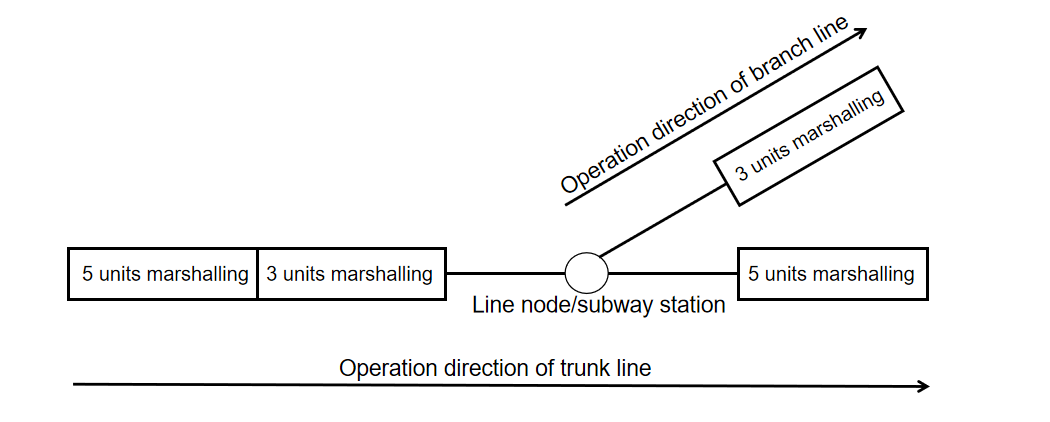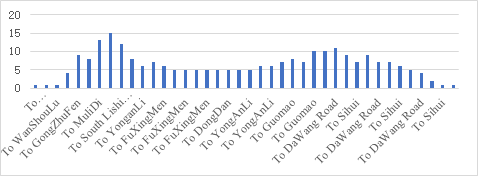1. Introduction
After the outbreak of the Covid-19 epidemic, urban rail transit has taken on many people, resulting in a huge hidden danger of virus transmission, which has brought great hidden danger to the epidemic prevention and control. The subway stations and carriages are relatively closed and crowded places and are facing unprecedented pressure. These measures have reduced the operational efficiency of urban rail transit to a certain extent and brought inconvenience to people's travel. Therefore, this study takes this contradiction as the starting point to explore an operation mode that can prevent and control the epidemic and reduce the risk of epidemic transmission while ensuring the transportation capacity.
This research takes train marshalling and dispatching as the research object and studies the dynamic train marshalling and dispatching method based on virtual marshalling under major epidemic situation. The purpose of this project is to explore more intelligent marshalling methods, optimize transportation organization, and improve the flexibility of train marshalling and dispatching of urban rail transit, to improve its transportation efficiency, reduce the density of personnel at the station, and reduce the risk of disease infection of passengers in the process of taking urban rail transit in the context of the epidemic outbreak.
2. Risk Analysis of Subway Epidemic Transmission
2.1. Analysis of Passenger Flow of Beijing Line 1

Figure 1: Time-sharing section passenger flow of Line 1(up-direction).
2.1.1. Time Distribution Characteristics
According to Figure 1, the time distribution of rail transit passenger flow is inseparable from the regularity of urban residents' travel time. With the change of urban life rhythm, the hourly passenger flow of rail transit is distributed in a hump shape in one day, with two peaks. Among them, the morning peak of going to work and school appears at 7:30~8:30; The evening peak is formed after work and school in the afternoon, which occurs from 17:30 to 19:00, and the passenger flow is flat peak in other time periods. A series of data of time-sharing section passenger flow of rail transit reflect the distribution and change of hourly passenger flow in a day.
2.1.2. Passenger Travel Characteristics
The average travel distance and transfer times of passengers are large. As a high cost and efficient fast transportation tool, the subway should play a key role in all modes of urban transportation, mainly attracting long-distance passengers. According to the survey [1], the average travel distance of Beijing subway passengers in the subway network is about 12 kilometers, indicating that passengers choose the subway to travel with obvious long-distance characteristics, and the backbone role of the subway in the transportation network is initially emerging.
2.2. Analysis of Subway Passenger Movement Behavior
The passenger flow of the subway rail transit station platform has the following particularity:
(1) Due to the limitations of equipment and facilities, passenger walking channels and other service facilities in the subway station, passengers' walking and pathfinding behaviors in the subway station are normative, and the walking space is limited, and the main direction of action is guided by the lines in the subway.
(2) The pedestrian flow at the platform level in the subway passage mainly concentrates at the entrance and exit stairs and escalators, the entrance and exit of transfer facilities and narrow passages; In addition, when the subway train arrives, a large number of passengers will rush into the train, which will also cause congestion.
2.3. Analysis of Subway Epidemic Situation
According to the social force model [2], with the increase of the total number of people leaving the station, the number of contacts between pedestrians and the number of infected people will increase. Under the same conditions, the fluctuation range of contact number results is larger. It may be due to the following effect of pedestrians. Because of the following effect, most of the infected people are pedestrians around the initial infected people, so the location of the initial infected people will have an important impact on the number of infected people.
3. Marshalling Mode

Figure 2: Relationship between different marshalling schemes.
3.1. Fixed Marshalling Scheme
Fixed marshalling is also called single marshalling, that is, fixed marshalling is adopted in different operation stages, such as 6-car marshalling, 8-car marshalling, etc. The coping strategy for different passenger flow periods is to adjust the number of trains running.
3.2. Variable Marshalling Scheme
Variable marshalling scheme is a special form of multi-marshalling scheme, that is, flexible marshalling [3]. Similarly, for the rail transit passenger flow with poor balance and obvious travel time, the fixed large and small marshalling trains in the multi-marshalling scheme are given the ability of flexible decoupling and reconnection, that is, the trains will undergo online decoupling at specific transfer or branch nodes, or offline decoupling at the end of the line; This scheme is flexible and highly matched with the change of passenger flow [4].

Figure 3: Schematic diagram of subway unmarshalling of Y-type line.
3.3. Multi Marshalling Scheme
Table 1: Specific forms of multi-formation schemes in various countries.
Multi Marshalling Scheme | Nationality | Line | Marshalling Scheme |
Consider the marshalling scheme during the operation period (morning or afternoon) | China | Guangzhou Metro Line 3 | Two 3-unit marshalling |
France | French Metro | 3/6/9 unit marshalling in different time | |
Austria | Vienna U-Bahn | 4/8 unit marshalling in different time | |
Consider the marshalling scheme during the different direction (close or far traveling) | China | Shanghai Metro Line 1, 2 | Mixed 6-unit & 8-unit marshalling |
Shanghai Metro Line 8 | Mixed 6-unit & 7-unit marshalling | ||
Japan | Inside line of Tokyo Maruki | Mixed 3-unit & 6-unit marshalling | |
Japan | Tokyo Deputy Metropolitan Line | Mixed 8-unit & 10-unit marshalling | |
France | Paris Line 6, 11 | Mixed 4-unit & 5-unit marshalling | |
United States | New York Subway | 8/11 excessive Marshalling |
We plan to adopt the public transit operation mode for urban rail transit. Each line will formulate the train operation schedule according to its own passenger flow characteristics, reasonably plan the train shifts, effectively control the passenger flow, use energy, and complete the efficient passenger transport task.
4. Dynamic Model of 3-train Variable Formation
Single vehicle driving on the line can be regarded as a general catch-up problem in the study and is constrained by the minimum safe distance [5], running speed and braking and traction capacity in the process of driving.
Reasonable assumptions:
1. The dynamic marshalling train is composed of a specified number of train sets. The running speed, acceleration, braking performance and passenger capacity of each train are identical.
2. Each independent train has the same length.
3. The state of formation establishment occurs and changes instantaneously or within a fixed time (without considering the interference generated in the process of delayed communication or mutual information or determining the delay time in advance).
4. After two train sets reach the minimum operation interval during the formation process, they shall be regarded as a stable train set unit.
5. When two train sets are greater than the braking safety interval during the formation process, they are immediately considered as two independent train set units.
Based on the above reasonable assumptions, the variable marshalling scheme can be described, and the basic dynamic model can be established.
4.1. Model Establishment
Based on the above reasonable assumptions, the variable marshalling scheme can be described and the basic dynamic model can be established.
Relative speed of train set:
\( |{v_{i-1}}-{v_{i}}|≤thv \) (1)
Relative distance of train set:
\( {p_{i-1}}-{p_{i}}-{al_{i-1}}-d_{i-1,i}^{ref}≤ths \) (2)
The above two formulas are used as the criteria for variable marshalling.
Operating speed constraint:
\( 0≤{v_{k+i|k}}≤{v_{max}} \) (3)
Minimum safety distance constraint:
\( {d_{min}}≤{d_{k+i|k}} \) (4)
Traction and braking capacity constraints:
\( {-P_{bre}}≤{v_{k+i|k}}*{v_{k+i|k}}≤{P_{acc}} \) (5)
Maximum number of groups constraint:
\( {a_{max}}≤\frac{{L_{S}}}{{l_{k+i|k}}} \) (6)
The state equation of single unit:
\( \begin{cases} \begin{array}{c} \dot{p}(t)={v_{i(t)}} \\ vi(t)=-ρ[a+bv(t)+c{v^{2}}(t)]+ρv(t)-ρ{ω_{i}} \end{array} \end{cases} \) (7)
In these above formulas, \( {v_{i}} \) is the stable running speed of train set \( i \) , \( thv \) is the maximum relative speed of train formation, \( {p_{i}} \) is the position of train head \( i \) of the train set, \( l \) is the train length, \( a \) is the number of trains, \( ths \) is the maximum relative distance of trains, \( d \) is the train operation interval, \( {L_{S}} \) is the length of platform \( S \) . \( ρ \) Is the resistance correction coefficient, \( a/b/c \) is the coefficient of Davis empirical formula, \( {ω_{i}} \) refers to the environmental resistance of the train set \( i \) during stable operation.
4.2. Model Solution
The model is solved directly for every 10 minutes and every 5 minutes, and the conclusion is as follows.

Figure 4: Number of train formation when entering the station.
The handling during the normal and peak periods is relatively simple, and departure at the frequency of 10 minutes/shift during the peak period will seriously affect the operation of the subway. Therefore, use the high frequency departure scheme in the peak period, and use the low frequency departure scheme in the flat or low peak area to maximize the occupancy rate of each carriage.

Figure 5: The final mixed marshalling scheme.
It is concluded that the mixed marshalling scheme can be obtained by changing the marshalling scheme at 7:30 11:00 17:00 19:30.
5. Dynamic Marshalling Adjustment
Due to the large difference in passenger flow between peak hours and peak hours, the passenger flow at different stations also varies greatly [6]. If the mode of marshalling adjustment can be added during the conversion between high and low peaks and when the train passes through different stations during operation, it can effectively improve the full load rate of the train and reduce energy consumption.
5.1. Formation Adjustment during Peak and Off-peak Periods
Generally, during the smooth transition period from early peak to flat peak, the running interval can be adjusted from one turn-back end, and then the marshalling adjustment can be made when the large interval train runs to another turn-back end [7].
The marshalling is from long marshalling to short marshalling, and the long marshalling trains need to be unmarshalled. The train unmarshalling process is as follows:
(1) The coupled train stops at the parking point in the unmarshalling area in the automatic driving mode according to the plan.
(2) The south signal system sends the decoupling command, or the driver presses the decoupling button to unlock the coupler.
6. Conclusion
Through comparative analysis, the dynamic marshalling train set has undergone a lot of optimizations and innovative design and has certain advantages. Based on digesting and absorbing the LTE scheme adopted in the existing subway line signal system, and summarizing years of operation and maintenance experience, the dynamic marshalling train has improved the utilization ratio of the train, greatly reduced the waste of resources, and also improved the convenience and comfort of passengers.
6.1. Adaptability Advantages
The manufacturing platform of dynamic marshalling train sets with different speed grades can adjust the number of marshalling according to the actual operation requirements, and manufacture the train sets according to the design speed requirements of the line to meet the needs of different lines such as intercity, short-distance transportation, routing, and crossline transportation between different lines.
6.2. Economic Advantages
By increasing or reducing the number of cars, dynamic marshalling train sets can improve the utilization rate of passenger carrying capacity cars, improve the operation efficiency and reduce the per capita operation cost.
6.3. Maintenance Advantages
The dynamic marshalling train set's motor car and trailer can be disassembled and replaced, which can shorten the maintenance time of the faulty train, realize the two standby modes of single train and the whole train, and reduce the standby rate of the whole train; It can realize the replacement maintenance of single vehicle, greatly reduce the time for advanced maintenance of multiple units, and improve efficiency.
6.4. Application Prospect
Considering the instability of passenger flow forecast, the improvement of future social living standards, the unexpected development of the subway system and other factors, according to the actual situation of the line, it is suggested to carry out the configuration of phased development and reserve a certain reserve capacity, which not only realizes the maximization of construction investment and operation income, but also provides a feasible idea for the sustainable development of the subway system.
References
[1]. Li Bing, Yang Xinyu, Wang Yanfeng. Analogic simulation optimization of passenger distribution system in rail transit station Journal of Intelligent Systems, 2020,15 (6): 1049-1057.
[2]. Chen Li, Du Caixiao, Yao Meng, Wang Gaoyang, Liang Boyang, Wang Jingyu, Liu Siqi, Li Yuzhe, Cui Haihang, Zhou Min. Micro-population infection and prevention and control in subway stations based on social force model. China Journal of Infection Control, 2022,21 (1): 22-29
[3]. Yan Honghui. Discussion on dynamic marshalling operation mode of smart metro [J]. Railway Technology Innovation, 2021 (S01): 75-81
[4]. CAO Yuan, Wen Jiakun, Ma Lianchuan. Train dynamic marshalling and dispatching under major epidemic [J]. Journal of Transportation Engineering, 2020,20 (3): 120-128.
[5]. ZHANG Yuzhuo,CAO Yuan,WEN Yinghong,LIANG Liang,ZOU Feng.Optimization of Information Interaction Protocols in Cooperative Vehicle-Infrastructure Systems[J] 2018,27(2):439-444.
[6]. Xun Jing, Chen Mingliang, Ning Bin, Tang Tao, Dong Hairong. Measurement of subway train tracking performance under virtual reconnection conditions [J]. Journal of Beijing Jiaotong University, 2019, 43 (1): 96-103
[7]. CAO Yuan,MA Lianchuan,XIAO Shuo,ZHANG Xia,XU Wei.Standard Analysis for Transfer Delay in CTCS-3[J],2017,26(5):1057-1063.
Cite this article
Alimu,K. (2023). Virtual Dynamic Marshalling of Trains under Severe Epidemic Situation. Advances in Economics, Management and Political Sciences,23,51-58.
Data availability
The datasets used and/or analyzed during the current study will be available from the authors upon reasonable request.
Disclaimer/Publisher's Note
The statements, opinions and data contained in all publications are solely those of the individual author(s) and contributor(s) and not of EWA Publishing and/or the editor(s). EWA Publishing and/or the editor(s) disclaim responsibility for any injury to people or property resulting from any ideas, methods, instructions or products referred to in the content.
About volume
Volume title: Proceedings of the 2023 International Conference on Management Research and Economic Development
© 2024 by the author(s). Licensee EWA Publishing, Oxford, UK. This article is an open access article distributed under the terms and
conditions of the Creative Commons Attribution (CC BY) license. Authors who
publish this series agree to the following terms:
1. Authors retain copyright and grant the series right of first publication with the work simultaneously licensed under a Creative Commons
Attribution License that allows others to share the work with an acknowledgment of the work's authorship and initial publication in this
series.
2. Authors are able to enter into separate, additional contractual arrangements for the non-exclusive distribution of the series's published
version of the work (e.g., post it to an institutional repository or publish it in a book), with an acknowledgment of its initial
publication in this series.
3. Authors are permitted and encouraged to post their work online (e.g., in institutional repositories or on their website) prior to and
during the submission process, as it can lead to productive exchanges, as well as earlier and greater citation of published work (See
Open access policy for details).
References
[1]. Li Bing, Yang Xinyu, Wang Yanfeng. Analogic simulation optimization of passenger distribution system in rail transit station Journal of Intelligent Systems, 2020,15 (6): 1049-1057.
[2]. Chen Li, Du Caixiao, Yao Meng, Wang Gaoyang, Liang Boyang, Wang Jingyu, Liu Siqi, Li Yuzhe, Cui Haihang, Zhou Min. Micro-population infection and prevention and control in subway stations based on social force model. China Journal of Infection Control, 2022,21 (1): 22-29
[3]. Yan Honghui. Discussion on dynamic marshalling operation mode of smart metro [J]. Railway Technology Innovation, 2021 (S01): 75-81
[4]. CAO Yuan, Wen Jiakun, Ma Lianchuan. Train dynamic marshalling and dispatching under major epidemic [J]. Journal of Transportation Engineering, 2020,20 (3): 120-128.
[5]. ZHANG Yuzhuo,CAO Yuan,WEN Yinghong,LIANG Liang,ZOU Feng.Optimization of Information Interaction Protocols in Cooperative Vehicle-Infrastructure Systems[J] 2018,27(2):439-444.
[6]. Xun Jing, Chen Mingliang, Ning Bin, Tang Tao, Dong Hairong. Measurement of subway train tracking performance under virtual reconnection conditions [J]. Journal of Beijing Jiaotong University, 2019, 43 (1): 96-103
[7]. CAO Yuan,MA Lianchuan,XIAO Shuo,ZHANG Xia,XU Wei.Standard Analysis for Transfer Delay in CTCS-3[J],2017,26(5):1057-1063.









